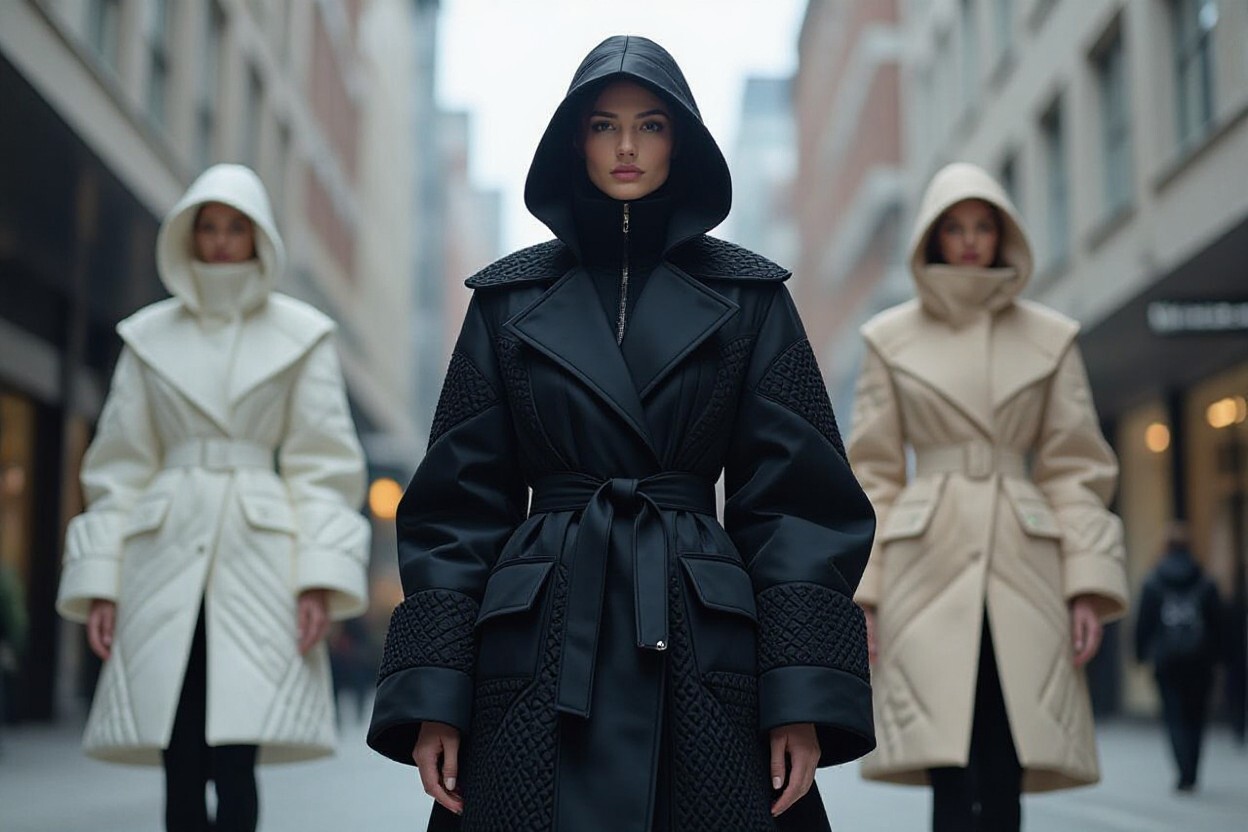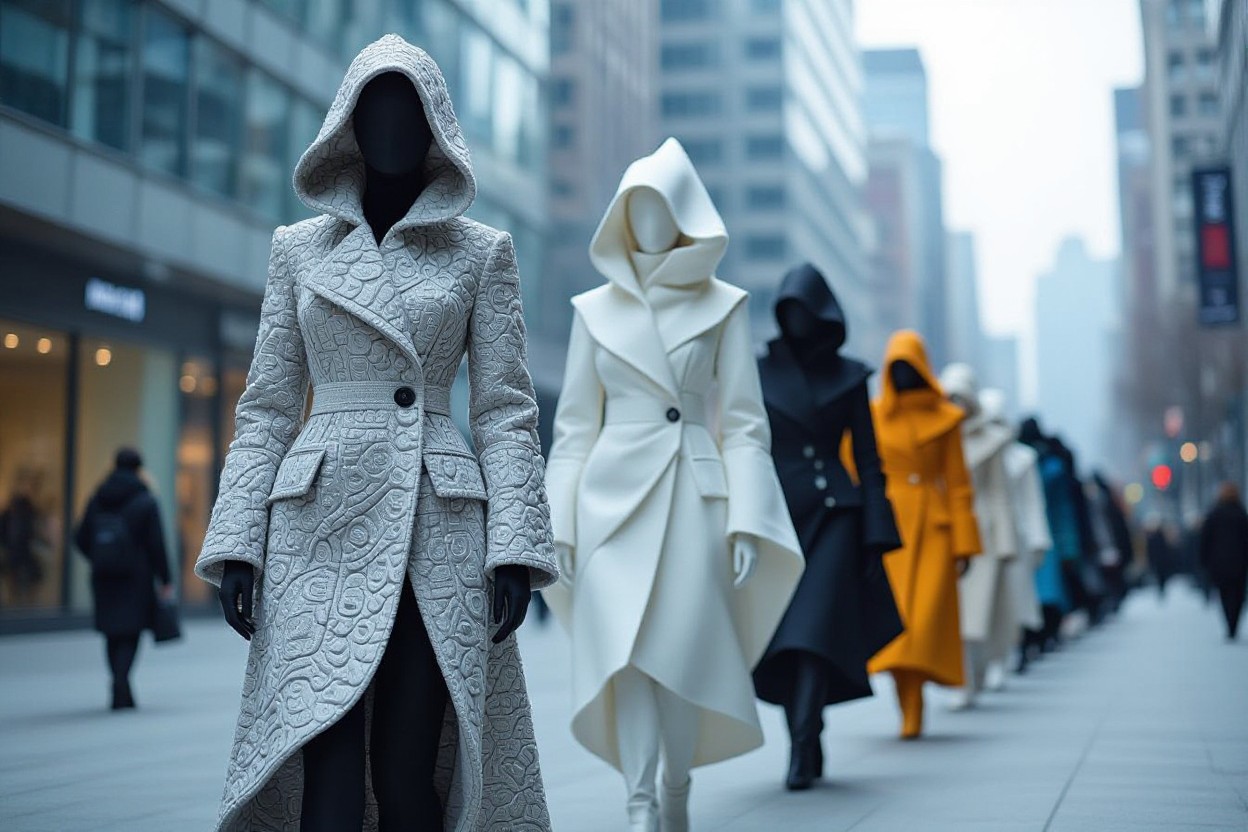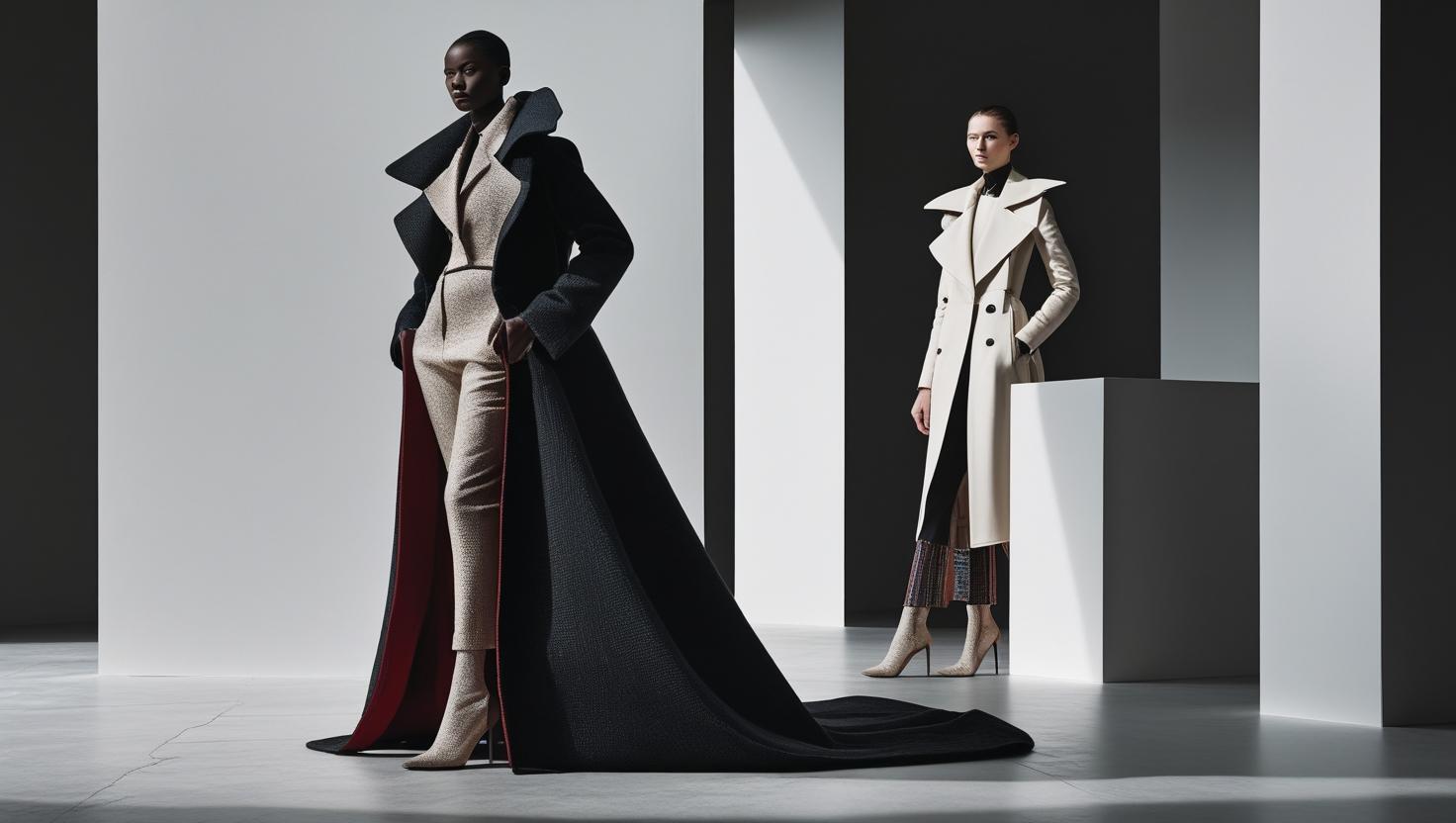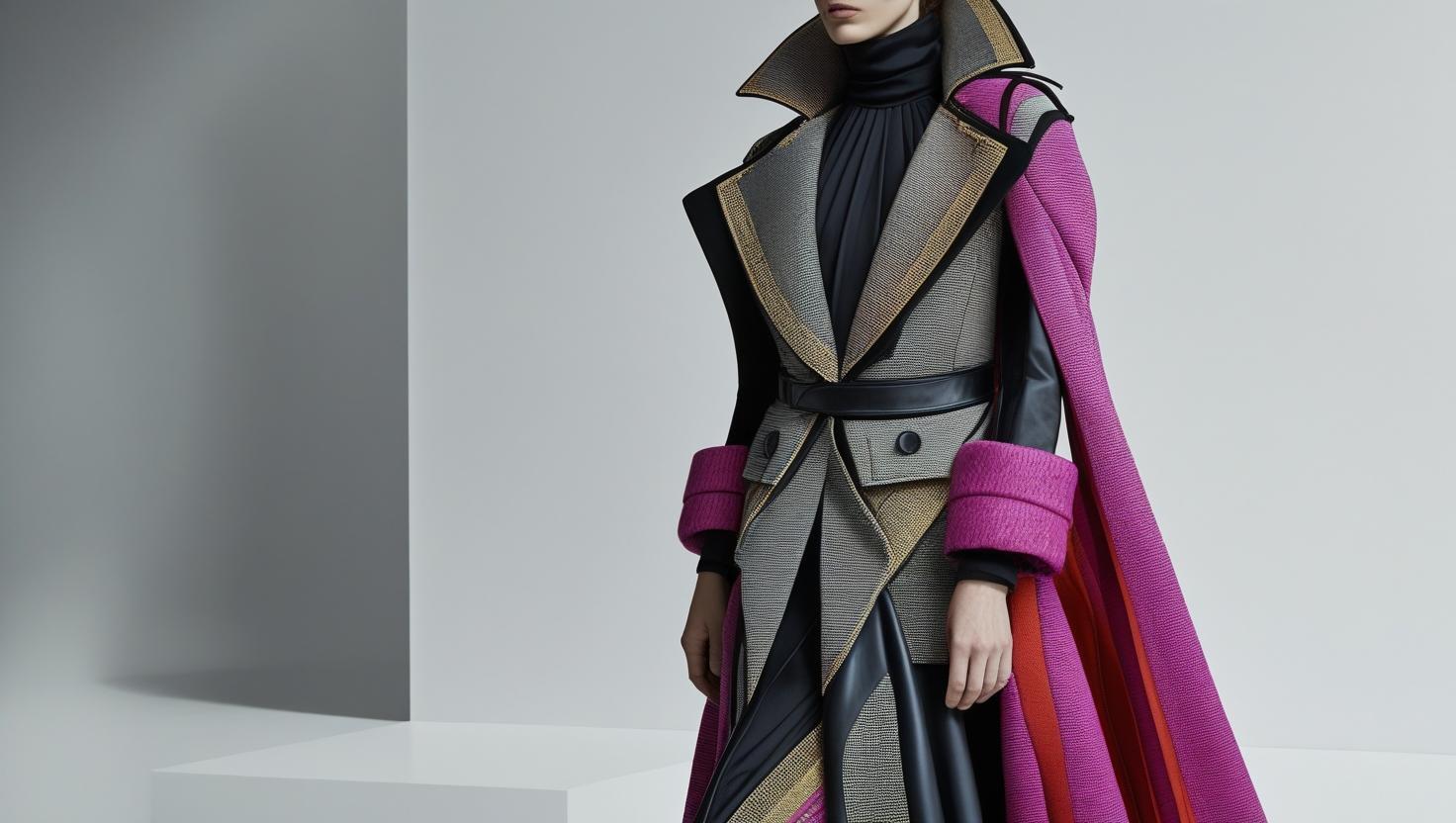12th Jul 2025
Sculptural Outerwear: When Coats Become Architecture

Many of you might view coats simply as functional garments, but sculptural outerwear transforms this perception by merging fashion with architectural design. When your coat becomes a structure, it challenges traditional shapes and embraces bold, innovative silhouettes that redefine your presence. You’ll find that these pieces not only protect against the elements but also serve as statement art, pushing boundaries in material and form. Exploring how coats evolve into wearable architecture reveals the exciting intersection of fashion, technology, and craftsmanship that can elevate your wardrobe to new heights.
The Intersection of Fashion and Architecture
The fusion of fashion and architecture reveals itself through outerwear that transcends traditional silhouettes, transforming coats into wearable structures. You witness innovative materials and geometric designs creating dynamic forms that not only serve aesthetics but also practical function, such as enhanced movement or protection. This approach challenges your perception of garments, positioning them as sculptural art pieces rather than mere clothing, with designers blending engineering principles and visual storytelling to shape space around the wearer.
Key Designers Blending Styles
Designers like Issey Miyake and Iris van Herpen lead the charge in merging architectural concepts with fashion. Miyake’s Pleats Please collection uses technology to manipulate fabric into structured, three-dimensional forms, while van Herpen incorporates 3D printing to sculpt ethereal, futuristic outerwear. Their work invites you to explore the boundaries of form and fabric, proving that innovative construction methods can redefine how outerwear interacts with the body and environment.
Historical Influences on Sculptural Outerwear
The roots of sculptural outerwear trace back to movements like Futurism and Bauhaus, which embraced geometric abstraction and functional design. Designers draw from these philosophies to transform coats into dynamic structures that reflect both art and utility. Your appreciation deepens when you consider how elements like exaggerated shoulders or asymmetrical cuts echo early 20th-century avant-garde experiments with form and space.
Expanding on these influences, the Bauhaus focus on simplified forms and favoring function over ornamentation laid the foundation for minimal yet bold outerwear shapes seen today. Futurism’s celebration of speed and innovation inspired angular, aerodynamic designs that echo through modern sculptural coats. Contemporary designers continue to reinterpret these historic aesthetics, combining them with cutting-edge materials to push outerwear beyond traditional boundaries into realms that challenge both your spatial awareness and fashion expectations.
Material Innovations Driving Design
Material advancements continuously reshape sculptural outerwear, pushing boundaries between fashion and architecture. Designers leverage 3D-knitted fabrics, thermoformed plastics, and metallic fibers to create garments that maintain rigid structures while providing comfort. These cutting-edge materials allow for dynamic shapes, such as exaggerated shoulders or voluminous collars, that respond to body movement. Incorporating such textiles transforms your outerwear into wearable sculpture, elevating both aesthetics and functionality.
Textiles That Transform Form
Innovative textiles like neoprene blends, laser-cut leather, and smart memory fabrics enable dramatic volume and precise angles in coats without bulk. For example, memory polyester can return to a set shape after deformation, allowing your coat to hold architectural folds or pleats that shift subtly with your movements. This fusion of technical fabric and design delivers outerwear with a crystallized form, offering you both sculptural impact and daily wearability.
Sustainable Practices in Architectural Outerwear
Bio-based textiles and recycled synthetics now play a significant role in your sculptural outerwear, reducing environmental impact while maintaining structural integrity. Brands experiment with plant-derived polyurethane and reclaimed nylon, creating innovative fabrics that support bold silhouettes without relying on traditional petroleum-based materials. This shift not only advances sustainability but also encourages designers to innovate forms that complement eco-conscious production methods.
Exploring sustainability further, several designers have incorporated circular design principles in architectural outerwear, ensuring garments can be disassembled and recycled at end of life. For instance, modular coats composed of detachable panels allow you to customize the silhouette and extend the garment’s usability. Additionally, companies like Bolt Threads use lab-grown spider silk to produce strong yet lightweight fabrics that hold sculptural shapes effortlessly. These approaches highlight how functionality, form, and environmental responsibility intertwine in modern outerwear design, offering you garments that are both statement pieces and mindful investments.

The Role of Technology in Sculptural Outerwear
Technology elevates sculptural outerwear from mere fashion statements to living, breathing artworks. By leveraging digital design tools and innovative manufacturing methods, designers can translate complex architectural concepts into wearable forms. This integration allows you to explore new textures, dynamic shapes, and interactive features that were once impossible with traditional tailoring. Technology not only enhances the structural integrity of garments but also expands your creative boundaries, resulting in coats that challenge conventional silhouettes and redefine outerwear's functionality and aesthetics.
3D Printing in Fashion
3D printing revolutionizes sculptural outerwear by enabling you to fabricate intricate, lattice-like structures that mimic architectural elements. Designers like Iris van Herpen use this technology to produce lightweight, geometric patterns that interlock seamlessly, creating garments with both rigidity and flexibility. With 3D printing, customization reaches new heights—your coat can be tailored to fit your body’s exact contours while showcasing avant-garde designs that are impossible to achieve with fabric alone.
Smart Fabrics and Wearable Tech
Smart fabrics integrate conductive fibers and sensors into sculptural outerwear, transforming your coat into an interactive experience. These materials can adjust insulation based on temperature changes or illuminate through embedded LEDs, enhancing both utility and visual impact. Wearable tech collaborations elevate your garment to a responsive interface that merges fashion with function, allowing you to engage with your environment in innovative ways.
Expanding on smart fabrics, companies like Bolt Threads have developed textiles such as Microsilk, which combines sustainability with functional performance, mimicking natural spider silk's strength and flexibility. Additionally, designers incorporate microcontrollers that sync with smartphones to regulate warmth or trigger light patterns, offering personalized adjustments at your fingertips. This fusion of material science and technology not only complements sculptural shapes but also pushes outerwear into a realm where design dynamically interacts with your lifestyle.

Cultural Reflections: Coats as Statements
When you don a sculptural coat, you're not only embracing a garment but also engaging with rich cultural narratives. These outerwear pieces often transcend fashion, becoming potent symbols of identity and societal values. Whether inspired by traditional craftsmanship or avant-garde innovation, such coats communicate intricate stories, reflecting the wearer’s worldview and the cultural moments shaping them.
Identity and Expression Through Outerwear
Your choice of coat can act as a visual manifesto, articulating personal identity through texture, silhouette, and form. Designers like Rick Owens employ exaggerated shapes to challenge norms, allowing you to present an edgier version of self. Meanwhile, elements like indigenous patterns or historical tailoring connect you to heritage, providing layers of meaning beyond mere aesthetics.
Political and Social Messages Embedded in Design
Coats often serve as canvases for political discourse, embedding messages that comment on social issues. You might notice pieces referencing climate activism through recycled materials or garments deconstructed deliberately to question consumption. Such designs compel observers to engage with pressing conversations, turning outerwear into wearable activism.
Exploring the impact of politically charged coats unveils how designers like Marine Serre incorporate upcycled fabrics, highlighting sustainability concerns. The 2020 collections featured crescent motifs symbolizing renewal amidst environmental crises, urging you to reconsider your relationship with consumption. Similarly, streetwear labels embed calls for racial justice through bold graphics and slogans, using outerwear as a platform to amplify marginalized voices. This strategic design approach means your coat can carry both aesthetic intrigue and forceful social critique, making it an artifact of cultural relevance.
Practical Considerations: Wearability Meets Artistry
Exploring sculptural outerwear means juggling the intricate dance between artistic vision and everyday usability. While these coats serve as wearable sculptures, their design must accommodate mobility, climate, and comfort. You’ll notice many designers employ lightweight, flexible materials like neoprene or bonded fabrics to maintain shape without restricting movement. Incorporating thoughtful closures, adjustable elements, and breathable linings ensures these pieces transcend runway novelty and become practical wardrobe staples. This convergence of functionality and form challenges you to rethink what outerwear can do beyond mere protection.
Finding the Balance Between Form and Function
When wearing sculptural coats, look for designs that enhance your silhouette without overwhelming it. Coats with exaggerated shoulders or structured volumes can be balanced by streamlined tailoring around the waist or hem. Designers like Iris van Herpen use innovative textiles that hold architectural shapes yet remain surprisingly flexible, allowing you freedom to move and stay comfortable. Prioritizing adjustable features such as detachable panels or hidden cuffs lets you adapt the piece to different settings and weather conditions, ensuring that form and function coexist harmoniously.

Styling Tips for Incorporating Sculptural Pieces
Pair your sculptural outerwear with minimalistic, solid-colored basics to let the coat remain the centerpiece of your look. Slim trousers or monochrome dresses create a clean backdrop that doesn’t compete with the sculptural drama. Footwear should lean toward streamlined silhouettes—think ankle boots or sleek loafers—to maintain balance. Accessories must be subtle; think delicate metals or small leather goods instead of heavy statement bags. This style strategy lets the coat’s architectural lines shine, ensuring your outfit looks deliberately curated instead of overdone.
Further refining your approach, consider these styling vitals:
- Neutral palettes amplify the structural details of your coat without clashing.
- Monochrome layering enhances depth and adds visual interest without distraction.
- Structured shapes in other elements keep your silhouette cohesive and intentional.
- Minimal accessories prevent overcrowding and maintain focus on the outerwear.
This disciplined styling approach encourages you to appreciate sculptural outerwear as functional art, transforming your daily outfit into a bold statement of architectural design and personal style.
To wrap up
From above, sculptural outerwear transforms your coat into a wearable piece of art, blurring the line between fashion and architecture. You engage with garments that shape your silhouette in unexpected ways, highlighting structure and form. This approach encourages you to view outerwear not just as protection against the elements, but as a bold statement that reflects your personal style and creativity. Embracing sculptural designs allows your wardrobe to become dynamic, innovative, and visually compelling in every setting.

